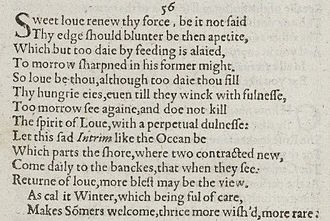Sonnet 56
Q1
Q2
Q3
C
Sweet love, renew thy force; be it not said
Thy edge should blunter be than appetite,
Which but to-day by feeding is allay’d,
To-morrow sharpen’d in his former might:
So, love, be thou; although to-day thou fill
Thy hungry eyes even till they wink with fullness,
To-morrow see again, and do not kill
The spirit of love with a perpetual dulness.
Let this sad interim like the ocean be
Which parts the shore, where two contracted new
Come daily to the banks, that, when they see
Return of love, more blest may be the view;
Or call it winter, which, being full of care,
Makes summer’s welcome thrice more wish’d, more rare.
4
8
12
14
Sonnet 56 is one of 154 sonnets written by the English playwright and poet William Shakespeare. It's a member of the Fair Youth sequence, in which the poet expresses his love towards a young man. The exact date of its composition is unknown, it is thought that the Fair Youth sequence was written in the first half of the 1590s and was published with the rest of the sonnets in the 1609 Quarto.
While "sonnet" originally referred to any short lyric, the English (or Surreyan or Shakespearean) sonnet has a definite form. The English sonnet contains three quatrains followed by a rhyming couplet. It follows the form's typical rhyme scheme, abab cdcd efef gg and is written in iambic pentameter, a type of poetic metre based on five pairs of metrically weak/strong syllabic positions. The fourth line exemplifies a regular iambic pentameter:
The meter demands a few variant pronunciations: Line six's "even" functions as one syllable, line eight's "spirit" as one and "perpetual" as three, line nine's "interim" as two, and line thirteen's "being" as one.
Two lines have a final extrametrical syllable or feminine ending, as exemplified by line eight:
Sonnet 56 is part of the Fair Youth sequence. This sequence spans sonnets 1-126. Furthermore, the first 77 sonnets are called the "Procreation" section, the rest 78-126 the "Rival Poet" and 127-154 is the "Dark Lady" section. In the Fair Youth section Shakespeare details his feelings towards the young man that he is in love with. This sonnet was published along with the rest in 1609 in Quarto. There is a debate as to why the sonnets were published in 1609. One theory affirmed by Duncan-Jones, is that these sonnets were published in order to "put right the wrong done" by the unauthorized publishing by Jaggard in 1599. They are thought to have been written long before the publication in 1609. Some researchers have used clues from Sonnet 107 with its allusions to Queen Elizabeth to date it to 1596. If the sonnets were written in the order that they appear in Quarto, then it is plausible that some were written before 1596.
...
Wikipedia

